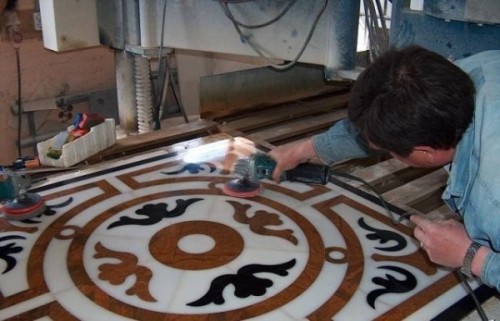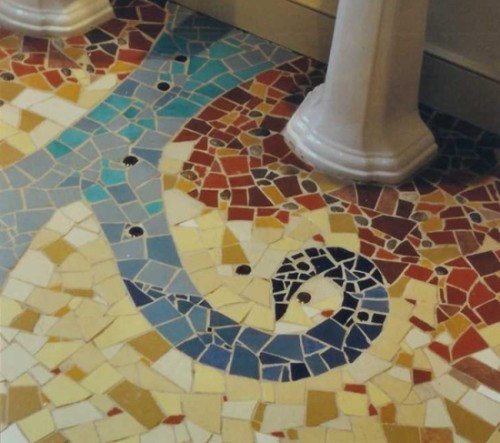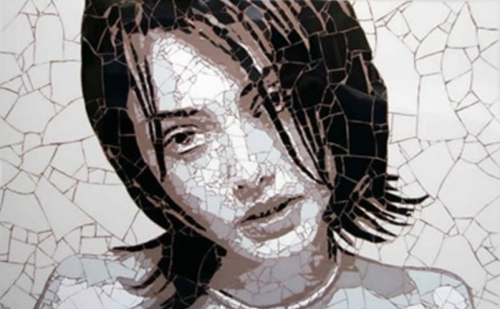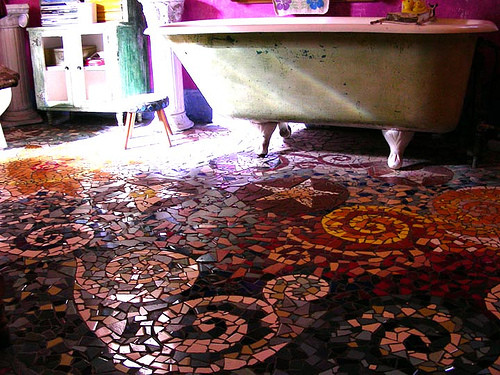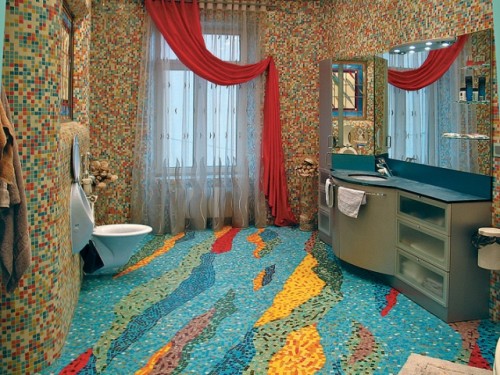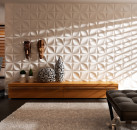Mosaic floors at first glance amaze with their splendor and sophistication. Durable and durable, they can last more than 100 years even in the most passable places. The technology for manufacturing such a sex is not so complicated as laborious. It requires a fairly patience and good taste. In this article we will tell you how to make a simple marble mosaic floor with your own hands.
Content
Mosaic floor Terrazzo
The main difference between the mosaic floors of Terrazzo and the usual concrete is that they are thin -layer, but, despite this, they make it possible to realize a much larger number of design ideas. This is a more decorative type of flooring, which is characterized by the same stability and durability as a strong concrete floor.
The concept of terrazzo combines all types of bulk mosaic floors. They differ only from the type of binder and filler material. So, the function of the mosaic can perform marble, sand, glass, fragments of ceramic tiles, decorative stones and other natural environmentally friendly materials.
In this article, we will consider the creation of a mosaic floor with marble crumbs, since this option is most popular. According to a similar scheme and technology, you can make floors with other fillers.
Depending on the use of the binder material, several types of terrazzo floor are distinguished:
- The thick floor is made on the basis of cement.
- The half of medium thickness is made of crumbs and a mixture of cement with polymer additives.
- The thin floor includes only mosaic elements and an addition of polymer components.
Marble floor
Mosaic floors today make mainly from marble due to its excellent operational qualities. This is a natural rock with an extremely high density and a characteristic crystalline structure. Marble does not absorb water, does not respond to chemicals and is quite easy to process. It is these qualities that are necessary to create the perfect sex, which will last more than one decade.
High aesthetic characteristics, as well as the ability to transmit in detail the natural texture, are widely used in construction, landscape design and interior design.
But to use entire marble slabs would not only be wasteful, but simply impossible - pure marble is not so often found. Therefore, an alternative and less costly way to use natural material was invented - the creation of marble crumbs. It is made of illiquid goods and waste production waste. It doesn’t matter what goes to the crusher - ritual plates or ordinary unprocessed breed - marble mosaic floors are equally strong and durable.
The dignity of the marble floor:
- strength (can be used even in places of high cross -country ability);
- concrete mosaic gender is resistant to moisture (can be done in the bathroom, pools);
- wear resistance;
- environmental friendliness;
- simple care;
- durability;
- does not give a spark for mechanical influences (can be used in workshops and at enterprises with increased fire safety requirements);
- aesthetics (with appropriate skills, you can create absolutely amazing floors with ornate patterns, paintings and ornaments).
Today, the market presents a wide range of marble crumbs, which differs in size of fractions, color and other characteristics. It is mainly used to arrange the floor in public institutions and on the street, since the marble coating will be too cold for the house.
Of the disadvantages of the marble mosaic floor, not only coldness can be distinguished, but also the exposure of crumbs under ultraviolet. Moreover, this is not only about painted products, but also by ordinary white marble - over time it begins to turn yellow.
Since the life of the marble floor can be measured for decades and even centuries, it can simply get tired of it. And if you want to change marble to parquet, serious problems will arise with the dismantling of the coating - it is very difficult to break the strong marble.
And the last delicate moment is the high cost of the mosaic floor of marble. The price of the service depends not only on the material used, but also on the pattern that you want to implement. As a rule, the layout of the pattern is paid separately, and for this work the designer is hired.
It is not so difficult to make a mosaic floor of marble crumbs, but for this it is necessary to clearly follow the instructions. So, first it is necessary to prepare the base - the draft floor must be leveled with a cement reinforced screed. Then - install the dividers, prepare the marble mixture, fill in and grinding. Let us consider in more detail each of the stages.
Preparation of the base
To prepare the base for laying a mosaic floor, it is necessary to remove the old floor covering, reaching the black floor. The ideal basis is a monolithic reinforced concrete slab or cement screed.
The course of work:
- If there are voids, seizures or cracks in the draft floor, they must be putty or pour the entire surface with the leveling mixture.
- Pay special attention to the places where the pipes entering the floor (risers in a multi -storey building).
- Process the base with hard brushes to increase the adhesive skills of the floor.
- Remove the entire garbage and blame the surface.
- Install the dividers. It is best to do this during the organization of cement screed, placing them one and a half meters from each other. The best delimiters are their square pipes with a side of 25 mm.
- If you are going to create a complex patterned pattern, you will need to install additional separators for each insert. To do this, use thin brass or aluminum plates of different shapes, less often - glass (for rapports or simple rectangular images).
Preparation of a marble mixture
To fill the mosaic marble floor will require a fairly large number of crumbs of various fractions. Different sizes of elements allow you to create a more interesting and “living” pattern. For floor creativity, crumbs of 5, 10 and 15 mm in diameter are usually used, selecting equal proportions of the material.
The specifics of the preparation of the working mixture:
- Mix the "multibill -sized" baby in equal proportions.
- Add cement (not lower than M400) in a ratio of 1: 3 or 1: 4.
- If you want to make a colored floor, use special natural dyes - marble flour, ocher, iron sword, chrome oxide and others. Pigments in the mixture should be no more than 30% of the total mass.
- Before adding water, mix all the components of the mixture thoroughly, then add the liquid portionably until a dense and sedentary mass is obtained. It is almost impossible to call accurate proportions and the amount of water, because different additives have different water absorption, so focus on consistency, constantly mixing the mixture.
Useful advice: Before adding marble crumbs to the solution, it should be well washed with dust from dust to ensure maximum clutch with cement and eliminate the formation of voids inside the floor.
Pour fill
The marble floor is filled with two layers, as a result of which an unusually strong coating is formed.
The course of work:
- Prepare a classic cement-sand solution M150. It should not be too thick to fill all the voids and align the floor defects.
- Moisten the base with a liquid cement mortar with highly diluted water. Distribute the composition on the surface with an ordinary broom or brush.
- Put the solution in cards and smooth out with a wooden rail or plastic ironer to get a perfectly even and uniform layer with a thickness of about 2 cm.
- When the lower layer hardens so that you can calmly walk on it (it is not necessary to wait for complete drying), you can proceed to the second stage of work - pouring a marble mixture. Evenly lay out the solution with marble chips into the cards between the separators and smooth it with a ironer, making shock-settings.
- When you filled all the cards, leave the surface to dry for 6-7 days.
Surface grinding
In order for the flooring to acquire shine and elegance, for which it is appreciated, it should be sanded. When the marble floor dries, you can proceed to the surface of the surface with abrasive materials. For this, a grinder with a large abrasive is used, which easily copes with the removal of the upper layer of hardened cement.
To facilitate and speed up the grinding process, moisten the surface with water and sprinkle it with a layer of small quartz sand. In case of discovery after grinding of potholes and voids, they should be filled with cement mortar and thoroughly wiped with marble bars.
If we are talking about creating an expensive floor with a complex pattern, after ordinary grinding it is required to be polished. Remove all the smallest garbage and dust, put on a grinder with a felt circle, apply a special paste on it and pass throughout the surface.
In order to prevent the floor to crack during drying, after laying it should be sprinkled with a cement-mram solution with a layer of wood sawdust, and then spray them with water as it dries (once a day).
Mosaic flooring
Laying mosaic floors can be carried out by filling, as described above, or by laying out each element or fragments. Actually, this is how a real mosaic has been created for centuries. If you need to make a reliable and moisture -resistant floor at home, it is not at all necessary to spend money on a massive and cold marble coating. A mosaic floor of tiles can easily be made with your own hands without even having professional skills.
The pleasant news is also that at this event you can strongly save using not a special mosaic tile, but a regular tile battle or completely fragments of ceramic dishes. You can buy such illiquid material in any large construction store or in the market.
Types of tile mosaics
For the manufacture of tile mosaics, not only ceramics or tiles are used. There is a striking variety of textures, materials, shades and colors, among which you can find the product for the most attractive taste.
Mosaic tiles happen:
- Tile - strong, durable, inexpensive, large selection of colors, textures, patterns.

- Glass - strong, hydrophobic, temperature resistant, original appearance.

- Ceramic - durable, does not respond to chemicals (can be used for the kitchen and bathroom), does not burn out, affordable in price.

- Concrete - more durable than the rest, frost -resistant, can be used on the street, withstands high loads, contains marble and granite intersperses. The disadvantage is a poor color palette.

- Metallic - stainless steel mosaic on a rubber base. Very stylish, although quite cold. Suitable for lining the floor in the kitchen, bathroom or hallway.

- Broken ceramics is a special type of mosaic that allows you to realize the most daring creative impulses. On the video - a mosaic floor made with your own hands from a bat tile:
Statement technology
If we are talking about laying special floor tiles, there is nothing complicated in this. In most cases, products are available in the form of plates from small fragments, which are laid on a cement or adhesive solution like conventional tiles. To describe this process will be an extra waste of your time, but this is really interesting is the creation of a mosaic floor from a broken ceramic or tile.
How can a beautiful and durable floor be made from an illiquid tile? If you want to save money and time as much as possible, you can buy a tile battle of one color scheme and lay pieces on the principle of a puzzle. But if you intend to create a real patterned mosaic, you need to know a few secrets.
The principle of laying mosaic floors is quite simple - the main contours of the picture are applied to the prepared base, the colors are marked, after which you can glue the tile. Then the space between the pieces of the mosaic should be wiped with a special composition of a suitable shade. It sounds elementary, but two methods of laying tiles on the floor are distinguished.
If you need to cover a small area, say, in the bathroom or toilet, you can quickly “throw” the image with a pencil or chalk and immediately glue the pieces of battles suitable in shape.
But if we are talking about a spacious room and a complex pattern on the floor, you will have to work properly. To lay out a flat and beautiful pattern as on a sketch, you must first collect fragments of the mosaic, and then glue them to the base.
How to do it:
- Lay a sketch on a real scale on a flat surface.
- Cover the sketch with a transparent film-sulfur stick with a sticky side up.
- Fasten the edges of the film with tape so that the drawing does not “move” during work.
- Separate the protective coating from the adhesive surface and lay out a fragment of the pattern according to the sketch. Repeat the procedure for all large or most complex fragments that you could not lay out “by eye”.
- Glue the fragments to the base, slightly drowning in the adhesive composition.
- Wait for the glue to dry and fill the seams between the tiles of the grout using a rubber spatula.
Useful trick: If you have a projector at your disposal, you can transfer the drawing to the floor or wall and put it much faster.
Tip: If you put mosaic tiles on the floor in the kitchen, it is better to cover it with protective grout varnish, so that randomly spilled coffee or wine does not leave ugly spots about yourself.
Finally, we suggest you see what masterpieces can be made from a regular tile battle:











